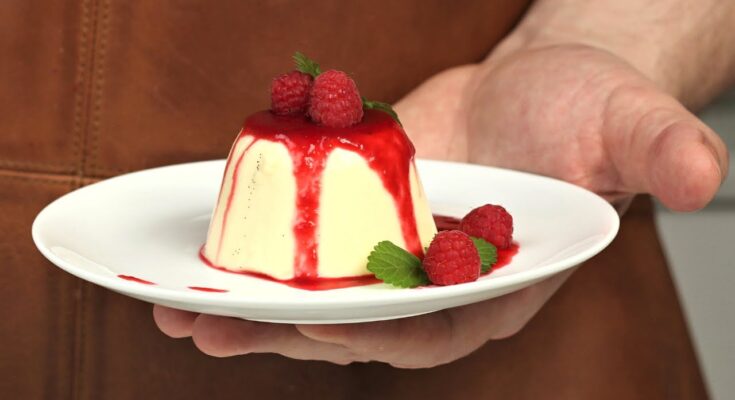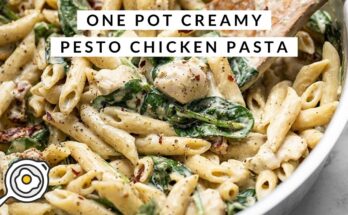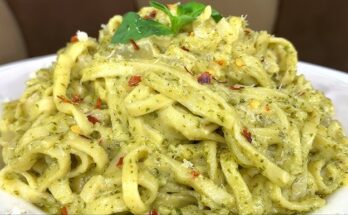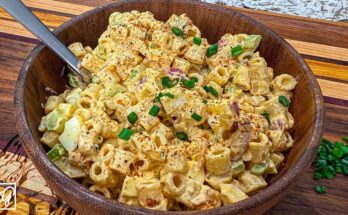Panna Cotta Recipe: Panna Cotta is a luxurious Italian dessert that translates to “cooked cream.” This delicacy is cherished for its silky texture and delicate sweetness, making it a perfect end to any meal.
Originating in Northern Italy, it has become a staple in fine dining restaurants worldwide, celebrated for its versatility in flavor and presentation.
Whether you’re a seasoned chef or a kitchen novice, this step-by-step guide will help you master the art of Panna Cotta.
Ingredients Needed for Panna Cotta
To make a classic vanilla Panna Cotta, you’ll need the following ingredients:
- Heavy cream (2 cups)
- Granulated sugar (1/3 cup)
- Vanilla extract (1 tsp) or one vanilla bean
- Unflavored gelatin (1 packet or 2 1/2 tsp)
- Cold water (3 tbsp)
For variations, you can also use ingredients like cocoa powder, espresso, or fruit purees to elevate the flavor.
Choosing Quality Ingredients: The quality of your ingredients greatly affects the outcome. Opt for fresh cream, pure vanilla, and unflavored gelatin for the best results. If possible, use organic or high-quality products for a richer taste.
Essential Equipment
Here’s what you’ll need to prepare Panna Cotta:
- Saucepan
- Whisk
- Measuring cups and spoons
- Small bowl (for blooming gelatin)
- Strainer (optional, for removing lumps)
- Ramekins, dessert glasses, or molds
Preparation Tips: Before starting, ensure all your equipment is clean and ready. Lightly oil the molds or ramekins for easier unmolding if needed. This small step saves time during plating.
Preparation Steps for Panna Cotta
Bloom the Gelatin:
- Sprinkle gelatin over 3 tablespoons of cold water in a small bowl.
- Let it sit for 5-10 minutes until it swells and becomes spongy.
Heat the Cream Mixture:
- In a saucepan, combine heavy cream and sugar.
- Heat over medium heat, stirring constantly until the sugar dissolves. Avoid boiling.
Infuse Flavor:
- Add vanilla extract or a split vanilla bean to the cream.
- Let it simmer gently for 5 minutes to infuse the flavors.
Add the Gelatin:
- Remove the cream from heat and stir in the bloomed gelatin.
- Whisk until the gelatin dissolves completely.
Strain the Mixture:
- For a super smooth texture, strain the mixture through a fine-mesh sieve.
Making the Perfect Cream Base
The cream base is the heart of Panna Cotta. Achieving the right balance between sweetness and creaminess is crucial. Heating the cream gently ensures it doesn’t curdle or scorch. Always stir to prevent the sugar from settling at the bottom, and use fresh vanilla for the best flavor.
Using Gelatin in Panna Cotta
Gelatin gives Panna Cotta its signature wobble. Whether you use powdered gelatin or sheets, blooming it in cold water first is key to activating its gelling properties. Never add gelatin directly to hot liquid—it will clump and ruin the texture.
Pro Tip: If you’re vegetarian, try using agar-agar as a substitute, but adjust the quantity as it’s more potent than gelatin.
Combining the Cream Base and Gelatin
To combine the gelatin with the cream base:
- Ensure the cream mixture is warm, not hot, to avoid uneven blending.
- Stir gently but thoroughly, ensuring the gelatin fully dissolves for a lump-free texture.
This step is critical for creating a uniform and silky dessert.
Pouring and Setting the Panna Cotta
Carefully pour the mixture into prepared molds, ramekins, or dessert glasses. To avoid air bubbles, pour slowly and tap the molds lightly on the counter. Refrigerate for at least 4-6 hours, or overnight for the best results. Patience is key!
Flavors and Variations
While vanilla is a classic choice, you can experiment with flavors like:
- Chocolate Panna Cotta: Add melted dark chocolate to the cream.
- Coffee Panna Cotta: Stir in espresso or instant coffee.
- Fruit-Infused Panna Cotta: Blend fruit puree with the cream mixture.
These variations allow you to customize the dessert for any occasion.
Preparing a Topping
Enhance your Panna Cotta with a complementary topping:
- Fruit Compote: Simmer fresh fruits with sugar and a splash of lemon juice.
- Caramel Drizzle: Make a quick caramel sauce for a rich, buttery finish.
- Chocolate Ganache: For chocolate lovers, drizzle melted chocolate over the top.
Serving Suggestions
Serve Panna Cotta chilled, directly in the molds or unmolded onto plates. Garnish with fresh fruits, edible flowers, or a sprinkle of crushed nuts for added texture. Pair it with a glass of dessert wine or a cup of espresso for an elegant touch.
Common Mistakes to Avoid
- Overheating the Cream: This can cause a grainy texture.
- Skipping the Straining Step: Leads to lumps in the dessert.
- Not Blooming Gelatin Properly: Results in uneven setting.
By avoiding these mistakes, you’ll create a dessert that’s as visually stunning as it is delicious.
Healthier Alternatives
For a lighter version of Panna Cotta:
- Replace heavy cream with coconut milk or almond milk.
- Use honey or stevia instead of sugar.
- Experiment with low-fat cream for a guilt-free treat.
Storing and Preserving Panna Cotta
Keep Panna Cotta covered in the refrigerator for up to 3 days. Avoid freezing, as it can alter the texture. If making ahead for a party, prepare the dessert the day before to save time.
FAQs about Panna Cotta Recipe
1. What is panna cotta?
Panna cotta is a classic Italian dessert that literally means “cooked cream.” It consists of sweetened cream thickened with gelatin and molded. The cream may be aromatized with coffee, vanilla, or other flavorings.
2. How long does it take to make panna cotta?
It typically takes about 15-20 minutes to prepare panna cotta, but it needs to set in the refrigerator for at least 4 hours or overnight, which makes it a perfect make-ahead dessert.
3. What type of gelatin is best for panna cotta?
You can use either powdered gelatin or gelatin leaves. If using powdered gelatin, ensure it’s properly dissolved in a little warm water before adding it to the cream. For gelatin leaves, soak them in cold water until soft, then squeeze out excess water and add to the warm cream mixture.
4. Can I make panna cotta without dairy?
Yes, you can substitute the cream with coconut milk or almond milk for a dairy-free version. Adjust the amount of sugar based on your preference and the sweetness of the milk substitute.
5. What are some popular toppings for panna cotta?
Panna cotta can be served with a variety of toppings such as fresh berries, caramel sauce, chocolate sauce, or fruit coulis. The simplicity of the dessert makes it versatile for pairing with different flavors.
6. How do I know when the panna cotta is set?
Panna cotta should be firm but still have a slight jiggle when gently shaken. It should not feel solid; the texture is meant to be creamy and silky.
7. Can panna cotta be frozen?
Freezing panna cotta is not recommended as it can affect the texture and consistency. It’s best enjoyed chilled from the refrigerator.
Conclusion and Final Tips
With this foolproof guide, you’re ready to create a stunning Panna Cotta that will impress your family and friends. Whether you stick to the classic recipe or experiment with flavors, this Italian dessert is bound to be a crowd-pleaser. So roll up your sleeves and give it a try!



